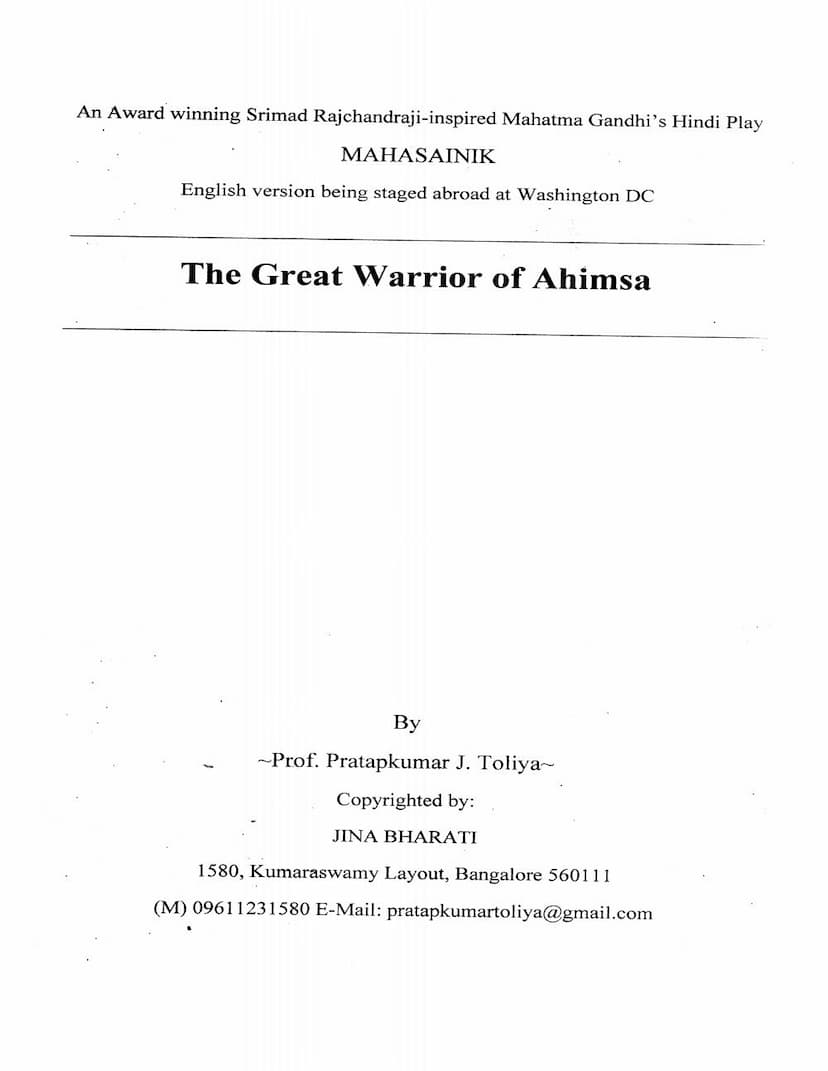Great Warrior Of Ahimsa
Added to library: September 1, 2025

Summary
Here's a comprehensive summary of the provided Jain text, "The Great Warrior of Ahimsa" by Prof. Pratap J Tolia, based on the provided pages:
Book Title: The Great Warrior of Ahimsa (also subtitled "Could There Be Such a Warrior?")
Author: Prof. Pratapkumar J. Tolia
Publisher: Vardhaman Bharati International Foundation
Core Theme: The play "The Great Warrior of Ahimsa" explores and promotes the philosophy and practice of Ahimsa (non-violence), drawing heavily on the teachings of Bhagawan Mahaveera, Srimad Rajchandraji, and Mahatma Gandhi. It posits that non-violence is not merely a passive concept but a powerful force capable of transforming individuals and influencing global events, even in the context of future warfare.
Inspiration and Lineage of Ahimsa:
- Bhagawan Mahaveera: The play traces the roots of Ahimsa to Bhagawan Mahaveera, emphasizing his compassion and the principle of "Inner War" against inner enemies like hatred and infatuation.
- Srimad Rajchandraji: He is presented as a crucial spiritual guide and influencer of Mahatma Gandhi. Srimad Rajchandraji, a modern Jain seer, practiced Ahimsa in his daily life and attained Atmajnana (self-knowledge). The play highlights his role as the "Maker of Mahatma" and his profound spiritual influence on Gandhi.
- Mahatma Gandhi: Gandhi is portrayed as the embodiment of Ahimsa in practice, applying it on personal, national, and global levels, leading India to independence through Satyagraha (truth-force). He is depicted as a unique "weaponless warrior" who proved that non-violence could be a potent force against oppression.
Key Aspects and Motives of the Play:
- Highlighting the Source of Gandhi's Power: The play aims to bring to light the often-overlooked spiritual guidance and influence of Srimad Rajchandraji on Mahatma Gandhi, arguing that he was the true "Maker of Mahatma."
- The Supremacy of Non-Violence: It asserts the power of non-violence as a weapon that can be applied even in future global conflicts, including "Star Wars." The play seeks to prove that a non-violent warrior is not an impossibility.
- Inspiring Future Generations: The play is intended to inspire future generations to adopt non-violent resistance and non-cooperation, even in challenging scenarios, by showcasing the practical application of these principles.
- Bridging Science and Spirituality: The author believes that in an age of advanced technology and potential global destruction (like nuclear wars), the integration of science with spirituality and non-violence is essential for humanity's survival.
Narrative and Dramatic Elements:
- Setting: The play is set in the year 2048 AD, during a future World War IV, depicting the battlefield of advanced scientific weapons.
- Characters:
- Buddhe Baba: An ancient (106-year-old) Indian "Peace Soldier" who embodies Gandhi's message of love, non-violence, and peace. He carries the legacy of Gandhi and aims to inspire a shift in perspective.
- Major General: A hardened, victorious warrior from World War III who is initially skeptical of non-violence but is deeply affected by Buddhe Baba's message and Gandhi's teachings.
- Srimad Rajchandraji: Appears in dream sequences, demonstrating his spiritual prowess and influence on Gandhi.
- Mahatma Gandhi: Appears in various age stages, showcasing his journey and the practice of Ahimsa.
- Other characters include Sarojini Naidu, Songster, Dandi-March Pedestrians, Marshal, Field Marshal, Soldiers, and Space Cosmonauts.
- Plot: The play follows the transformation of the Major General. Initially a formidable warrior, he is challenged by Buddhe Baba's message and Gandhi's recorded speeches and writings. Through a series of dream sequences and introspective moments, the Major General begins to question the efficacy of violent warfare and embraces the principles of non-violence, ultimately deciding to transform his "Space Force" into a "Peace Force."
- Symbolism: The play uses symbolic elements like the Yellow Scarf (worn by Peace Soldiers), the Dandi March, and the transformation of the Major General's weapons to represent the triumph of peace and non-violence.
- Musical and Visual Effects: The play incorporates various musical instruments, sound effects, and stage techniques to enhance the emotional impact and convey the spiritual and philosophical themes. The songs are presented in multiple languages, including Sanskrit, Prakrit, Hindi, Gujarati, and Bengali.
Author's Background and Personal Connection:
Prof. Pratapkumar J. Tolia's extensive background in Jainology, literature, music, and his personal encounters with Gandhian figures like Vinoba Bhave and his time spent with Mahatma Gandhi himself (as a young volunteer) deeply inform the play. He emphasizes his family's adherence to Jain principles and the profound influence of Srimad Rajchandraji and Mahatma Gandhi on his life and work. His personal experiences during communal riots in Ahmedabad in 1969, where he served as a "Shanti Sainik" (Peace Soldier), further solidify his belief in the practical application of non-violence.
Critical Reception:
The play has received praise from critics and scholars for its theme, emotional impact, imagination, and the way it highlights the ideals of Ahimsa, drawing connections between great spiritual and political leaders.
Conclusion:
"The Great Warrior of Ahimsa" is a thought-provoking play that advocates for non-violence as a powerful and transformative force, applicable even in the face of advanced warfare. It underscores the interconnectedness of spiritual traditions and their impact on societal and global change, presenting a vision of a future where peace and compassion prevail. The play is a testament to the author's deep commitment to these principles and his desire to inspire a similar dedication in others.